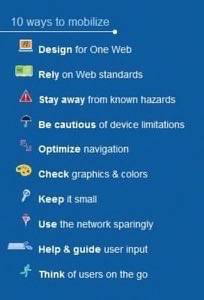Earlier this month, the World Wide Web Consortium announced the availability of the W3C mobileOK checker, a free service that performs various tests on a Web page to help you determine its level of mobile-friendliness.

According to W3C Director Tim Berners-Lee, mobileOK checker builds on the suite of quality assurance tools already offered by W3C and “does a nice job helping you improve your content one step at a time.”
To help ensure the best user experience across a variety of mobile devices, the Mobile Web Best Practices Working Group defined a set of recommended guidelines to follow when creating Web documents: the Mobile Web Best Practices 1.0 specification.
From there, the working group determined which tests could be automated and the mobileOK checker was created.
Some of the recommendations offered by the mobileOK checker include:
- XHTML Basic 1.1. for markup format
- Images should be small, either GIF or JPEG, and have alt attributes
- Remove whitespaces and comments by adding a cleaning step in the publication process (e.g. through tidy)
- Keep page size under 20 KB, and the markup under 10 KB to ensure timeliness of retrieval and rendering by mobile devices
- If you use scripts, ensure scripting support is not required
- Don’t use frames, pop-ups or applets
- Formats that require plugins are likely to break on mobile devices.
While the W3C points out that being mobileOK is not a guarantee that a Web document will be rendered correctly across all mobile devices or that user experience is a certainty, it is definitely a good place to start if you want recommendations on how to make your site more mobile friendly.
Flipcards

Other useful resources from the W3C include the Mobile Web Best Practices Flipcards that summarize the Mobile Web Best Practices 1.0 document. A PDF version of the cards is offered, and they are available in French, German, Korean and Spanish.









